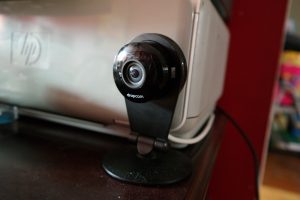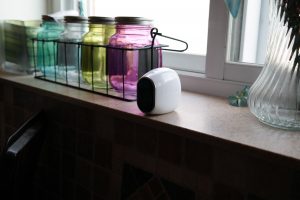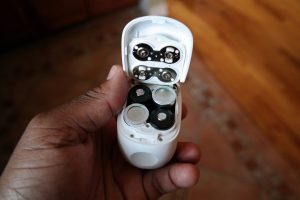
It has been awhile since we put another Building a Smart Home Series post. When we last left off in part 5, we had just got automated with the SmartThings system. This was back in March and I’ve really just been getting used to the automation and do have a few things to say about it. But that will be for a future post. Today in part 6 I want to talk about watching over your home when you’re not around. This will be about home surveillance. The smart home can be great for many things, but when you leave the home to go to say work or for recreational activities, what smart uses are available for you to keep an eye on what is happening back at HQ.
Back in the day your only real options where to subscribe to a security services like ADT or similar. You’d paid them a monthly fee and they added a bunch of sensors and/or cameras around your house, and they’d alert you when something was amidst. But now a lot of this can be done DIY and without the monthly recurring fee. One of those is of course surveillance. Today I will be talking about two of them, one of them is called Dropcam (which is owned by Nest, who in turn is own by Google) and the other is the Arlo system (who is own by Netgear). I must note that Dropcam who is owned by Nest, will be sun-setting as stock runs out and will be replaced with the new Nest Cam which shares a majority of the functions and features of Dropcam. While I wait to receive a unit for testing, I will speak on the merits of Dropcam and let you know what functions are still or no longer available in the new Nest Cam. Both Arlo and Drop/Nest Cam will watch the areas you setup it in and alert you when there is activity, but of these go about it in a few different ways.
Dropcam / Nest Cam
 Dropcam has been around for a little while now and it was the first camera I think of if you want something that isn’t too expensive and easy to set up. With Dropcam, set up is easy as you simple plug it in, connect to your WiFi and then configure. Most setup times take about 5-10mins. The most time you’ll spend on it is deciding where and at what angle you want it facing in. The Dropcam Pro will cost you (if you can still find one) anywhere from $149-$199. The new Nest Cam will cost you $199. Both of those is the price for one camera. The Dropcam PRO shoots video in 720p, while the Nest Cam shoots in 1080P video.
Dropcam has been around for a little while now and it was the first camera I think of if you want something that isn’t too expensive and easy to set up. With Dropcam, set up is easy as you simple plug it in, connect to your WiFi and then configure. Most setup times take about 5-10mins. The most time you’ll spend on it is deciding where and at what angle you want it facing in. The Dropcam Pro will cost you (if you can still find one) anywhere from $149-$199. The new Nest Cam will cost you $199. Both of those is the price for one camera. The Dropcam PRO shoots video in 720p, while the Nest Cam shoots in 1080P video.
After you have the Drop/Nest cam set up, you can do a few things. Both cameras are powered by an AC adapter and unless you configure it to do so, they are always on and shooting. You can view the live stream from either the webpage at (www.nest.com) or you can view from your phone with the Nest app, which is available for Android or iOS. You can also set up alerts so when you’re not home, if something moves or makes a sound in view of the camera it can send you an email. Both camera also night vision so even in the dark, you can get a view of what is going on. And if that wasn’t enough, it also has a mic so if you are using it as a Pet cam, you can talk to your pet as well.
 The last feature I like about the Drop/Nest cam is the video recording service. This isn’t mandatory, but if you subscribe to this optional service, you can also get like recording of the day as well. These recording can play back days of footage so if you wanted to go back in time to check something, this will give you the option. Now with the new Nest cam, Nest is calling this function Nest Aware. They are offering as a 10 day video history plan for $100/year (less than $10 a month) and 30 day video history plan for $300/year ($25 a month). Now again the price of a Nest cam is $199, so if you want to have a few placed around the house, you could start to add up on cost, but if you just want a live feed and alerts, you’ll have no recurring monthly cost.
The last feature I like about the Drop/Nest cam is the video recording service. This isn’t mandatory, but if you subscribe to this optional service, you can also get like recording of the day as well. These recording can play back days of footage so if you wanted to go back in time to check something, this will give you the option. Now with the new Nest cam, Nest is calling this function Nest Aware. They are offering as a 10 day video history plan for $100/year (less than $10 a month) and 30 day video history plan for $300/year ($25 a month). Now again the price of a Nest cam is $199, so if you want to have a few placed around the house, you could start to add up on cost, but if you just want a live feed and alerts, you’ll have no recurring monthly cost.
Arlo Video Security System
 The Arlo video security system is own by Netgear and I’ve tried this one out for the last several months. Arlo it pretty easy to set up as well, but does have a few more pieces to it for the process. With Arlo instead of each camera connecting to your WiFi network, a base unit connects to your network and the camera connect to the base unit. Setup was easy enough, after you connect the base to your network you connect the cameras to the base and your all good to go. The Arlo system is sold in bundles. The base bundle will give you one cameras and the base unit for $199.99. This will also come with 7 days of free cloud recording. The Arlo camera shoots in 720p HD quality like the Dropcam PRO but unlike the new Nest cam.
The Arlo video security system is own by Netgear and I’ve tried this one out for the last several months. Arlo it pretty easy to set up as well, but does have a few more pieces to it for the process. With Arlo instead of each camera connecting to your WiFi network, a base unit connects to your network and the camera connect to the base unit. Setup was easy enough, after you connect the base to your network you connect the cameras to the base and your all good to go. The Arlo system is sold in bundles. The base bundle will give you one cameras and the base unit for $199.99. This will also come with 7 days of free cloud recording. The Arlo camera shoots in 720p HD quality like the Dropcam PRO but unlike the new Nest cam.
 The defining feature of the Arlo systems has to be that its camera are 100% wireless. They run on replaceable batteries and without that power cord to chain to one location, you can really open up the area of where you place the camera. Arlo camera also have magnetic camera mounts which really likes the angle of how the camera face go well beyond what most can. With the magnetic mount you can really get your camera into some funky angles. Feel like doing some mission impossible surveillance, this will help you get there. One of the draw back to this though, you’ll really need to be on top of your batter levels. A dead camera is very much helpful when you need to be protected. The battery should last about 4-6 months and they aren’t your typical pick up a pack of Double A at the local store type of battery. So make sure you get some in stock for when that time comes.
The defining feature of the Arlo systems has to be that its camera are 100% wireless. They run on replaceable batteries and without that power cord to chain to one location, you can really open up the area of where you place the camera. Arlo camera also have magnetic camera mounts which really likes the angle of how the camera face go well beyond what most can. With the magnetic mount you can really get your camera into some funky angles. Feel like doing some mission impossible surveillance, this will help you get there. One of the draw back to this though, you’ll really need to be on top of your batter levels. A dead camera is very much helpful when you need to be protected. The battery should last about 4-6 months and they aren’t your typical pick up a pack of Double A at the local store type of battery. So make sure you get some in stock for when that time comes.
The Arlo once setup and placed will let you watch a live feed of what is happening at your home via its Arlo app (available for Android & iOS). With Arlo I would call this on-demand. To converse battery it isn’t running all the time. When you log into the app, you click on the camera you want to view and then it will start-up the stream for you. If you are not viewing or something hasn’t alerted its motion sensor, it will be in kind of stand by mode. This make sense as it isn’t drawing power from an always on supply of energy but a battery. To keep the battery this stand by time is needed, otherwise you’d see you battery last a lot less than 4-6 months.
 As I mentioned earlier, Arlo gives you 7 days of free cloud recording. If you need to check to see if anything happened you’d be able to do so. This is great if you don’t need that much footage to check and most times if an alert comes up, you’ll just want to see what happened at that moment. 7 days is more than enough and great that Arlo offers it for free. A couple of things that Arlo doesn’t offer like the Nest cam is both sound and speaking. Video playback seems to be video only, so if you wanted to hear what was happening as well, you wouldn’t be able to do this. And if you was using it as a pet cam, you wouldn’t be able to talk to Fido either. These were some of the trade offs I noticed. However if you needed a pure security system with video only, some cloud recording to play back an alert, that is also quite to set up yourself then Arlo is a good system for this. It is sold again in bundles with at the low it with one camera it is $199 and at the high-end with 4 cameras it is $499.99
As I mentioned earlier, Arlo gives you 7 days of free cloud recording. If you need to check to see if anything happened you’d be able to do so. This is great if you don’t need that much footage to check and most times if an alert comes up, you’ll just want to see what happened at that moment. 7 days is more than enough and great that Arlo offers it for free. A couple of things that Arlo doesn’t offer like the Nest cam is both sound and speaking. Video playback seems to be video only, so if you wanted to hear what was happening as well, you wouldn’t be able to do this. And if you was using it as a pet cam, you wouldn’t be able to talk to Fido either. These were some of the trade offs I noticed. However if you needed a pure security system with video only, some cloud recording to play back an alert, that is also quite to set up yourself then Arlo is a good system for this. It is sold again in bundles with at the low it with one camera it is $199 and at the high-end with 4 cameras it is $499.99
How Does It Connect To The Rest of The Smart home?
If you are building a smart home, you don’t just want a bunch of devices that have different interfaces, different apps, separate for everything else. If you are building a smart home, the devices you add to your system should at the very least talk to the other devices in your home. When this happens it makes life easier as one device can perform an action or job based on the action of another device. For example, you smart camera can be the eyes of your home. Let’s say you are arriving home at night and your camera sees you, if it can connect/talk to other devices, it can tell your smart hub that you are home and make turn on the lights or unlock the front door. Going further it could possible start-up your favorite playlist on Sonos or turn up the heat on a cold winter night. Your devices should be able to connect to each other, while it isn’t a reason to not buy a product, it should be a considering reason to think about.
Be warned, however, that while smart device ecosystems are convenient, they can introduce a plethora of threats and expose existing network vulnerabilities. Because of this, it’s important you secure your network when using smart devices. This can be done in a few ways, including using a router connected to a VPN. This will ensure that your whole network is encrypted so any data traveling through it is hidden from anyone trying to gain access.
With the two systems I mentioned today, Dropcam (which is sun-setting) was able to connect to the SmartThings hub and be used within that system. Will the new Nest cam work with it as well? This is something I’m trying to find out now myself as well. However the new Nest cam has an ecosystem as well in Nest’s “Works with Nest” label. So the Nest cam will have few partners it can connect/talk to as well. Arlo however now doesn’t seem to talk to any other devices. This could change in the future, but right now it is on an island by itself.
There are tons of smart camera/security systems that have popped up recently. These two are only but a few. But when you are looking for something to add into your smart home, look for something that is easy to set up, not very costly, can talk to other devices, and works for the areas you want to view/protect.
